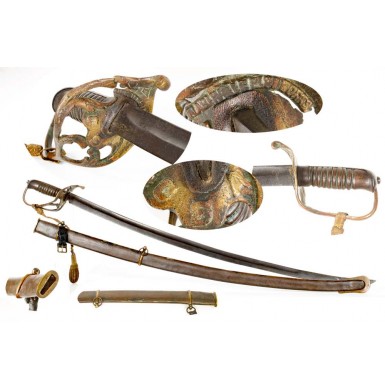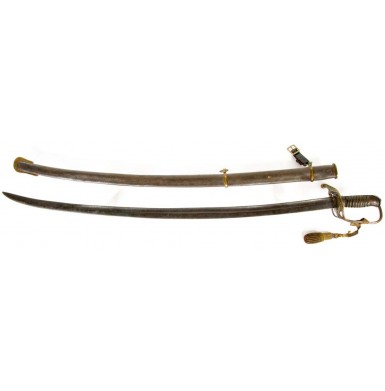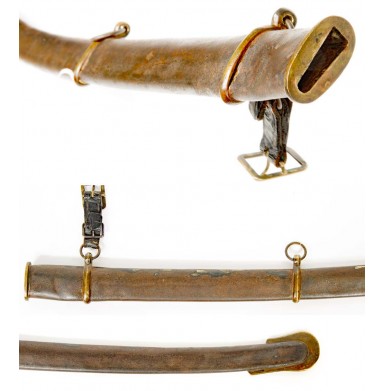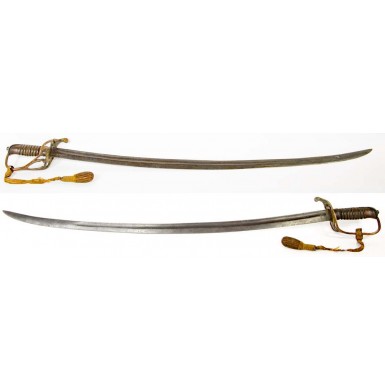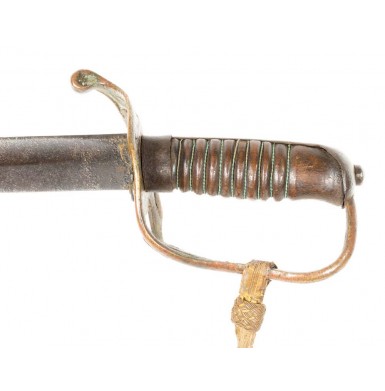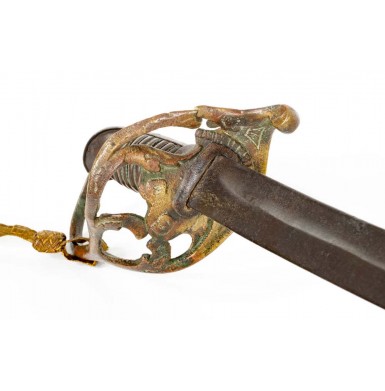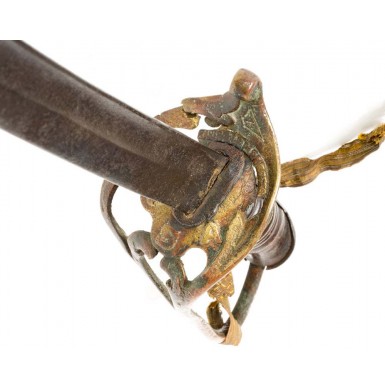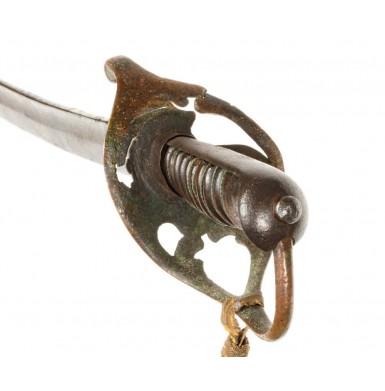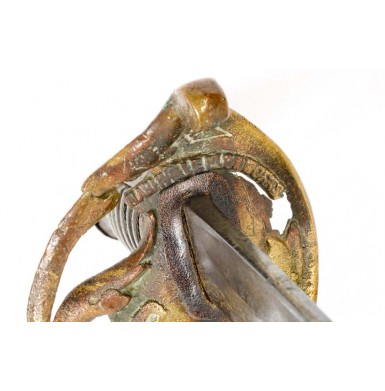Nashville Plow Works Cavalry Officer's Sword - Attic & Untouched
- Product Code: EWSK-1578-SOLD
- Availability: Out Of Stock
-
$1.00
On August 10, 1859, the Nashville newspaper The Tennessean ran an advertising announcement that noted that the former proprietor of the Tennessee Plow Factory, A.W. Putnam, had turned the operation of the business over to Messrs. Sharp & Hamilton. Thomas Sharp and J.T. Hamilton were noted by the former operator to be “practical mechanics”. Putnam went on to say that he could “cheerfully commend them as worthy of favor and extensive patronage.” The business was located on the Franklin Turnpike (8th Avenue South in Nashville today) about a mile south of the Public Square. Today a State of Tennessee historical marker is erected near the original factory location at 8th Ave. South and Palmer Place, only yards from Cannery Row. The pair ran the firm, known locally as the Tennessee Plow Factory, as well as Putnam’s Plow Factory, for less than a year before the business was destroyed by fire. According to articles printed on June 29, 1860 by both The Tennessean and the Daily Nashville Patriot, the manufactory was destroyed by a fire that erupted between 11:00 PM the previous evening and 12:00 AM on the 29th. The losses were reported variously at between $26,000 and $35,000. The building, valued at $17,000, was “a complete wreck” but was fully insured by the Bluff City Insurance Company of Memphis. However, Messers. Sharp & Hamilton reportedly suffered an uninsured loss of some $15,000 in equipment, machinery and raw materials. Not to be deterred, the pair set about to rebuild the business. The owner of the building, as well as the majority of the machinery, was A.W. Putnam; from whom they had acquired the operation of the business. On July 7, 1860, Putnam published a plea for financial assistance in the The Tennessean for the pair. Between Mr. Putnam’s insurance, assistance from the citizens of Nashville, and the hard work of Sharp & Hamilton themselves, the pair raised the business from the ashes like the proverbial Phoenix and the new firm was christened the Nashville Plow Works.
The first reference that I could located for the Nashville Plow Works was an October 18, 1860 advertising notice in The Tennessean stating that Sharp & Hamilton had rebuilt their facility and had even expanded it, increasing their manufacturing capabilities. For nearly a year, the pair would continue to manufacture all forms of agricultural equipment, while the clouds of Civil War gathered. With the election of Abraham Lincoln as the president of United States in November of 1860, the final movement towards southern secession were inexorably put into motion. The secession of South Carolina, on December 20, 1860, followed by Mississippi on January 9, 1861 started a domino effect resulted in seven southern states seceding before the opening salvo of the American Civil War was fired on April 12, 1861 with the bombardment of Fort Sumter. Three additional states followed in quick succession, with Tennessee being the eleventh and last state to officially secede from the Union on June 8, 1861. With the state now on a war footing, much of the industrial capabilities of Tennessee now turned their attention to production of arms and material to support a war effort. Both the Nashville Plow Works of Sharp & Hamilton and Cunningham & Company (later known as College Hill Arsenal) turned their attention from the manufacture of farm implements to the production of edged weapons. At this time most historians make the hackneyed reference to the Biblical verse Isaiah 2:4 “…and they shall beat their swords into plowshares,” noting that these Nashville companies, in particular Nashville Plow Works, had reversed the intention of the statement. More realistically, however, the firms followed the Biblical verse Joel 3:10, which instructed the reader to “Beat your plowshares into swords and your pruning hooks into spears. Let the weakling say, ‘I am strong.’”
The first reference that I can find to Sharp & Hamilton producing edged weapons comes from a notice in the Saturday September 21, 1861 Daily Nashville Patriot, where a Mr. H.L. Justice has taken out an ad offering land for sale in the Nashville area. Mr. Justice notes that “I can be seen during the day at Sharp & Hamilton’s Sword Factory”. The very first receipt that I can find for the sale of Sharp & Hamilton sabers is dated October 4, 1861. This receipt is for “81 Sabers, Cav”at a total price of $851.50, roughly $10.50 each. The receipt also shows the sale of 33 pounds of zinc @ $0.15 per pound and 220 pounds of copper at $0.30 per pound. Six days later, on October 10, another receipt notes the delivery of “100 sabers @ $10.50” each, followed by 19 more on October 12 and an additional 58 on October 30. Sharp & Hamilton delivered a total of 258 cavalry sabers to the Confederacy that month, at a standard unit price of $10.50 each. Deliveries of both cavalry sabers and raw materials continued for the next four months. Records indicate in November the unit price was increased to $11.00 each, with 100 sabers delivered that month, 213 delivered in December and 229 delivered in January of 1862. In all, 800 sabers were delivered by the firm between October 1861 and January 1861. Additionally, Sharp & Hamilton sold the Confederacy 236 pounds of zinc, 798 pounds of copper and 102 pounds of lead, with the final raw material sales taking place on February 7, 1862.
It seems likely that all of the 800 sabers that were delivered by Sharp & Hamilton were enlisted cavalry sabers. Many of these are almost certainly the Sharp & Hamilton sabers that appear, both marked and unmarked, with a bird’s head grip profile, an iron backstrap and capstan nut, a nine-groove leather-covered wood grip with twisted brass wire and a cast brass guard. It is possible that some of the unmarked, brass hilted plain cavalry sabers with the hilt shape more often referred to as “Nashville Plow Works” were part of these deliveries as well. As officers were required to purchase their own weapons and equipment, officer’s sabers were rarely contracted for by the Confederacy. The handful of times that I have encountered receipts for the purchase of officer’s sabers, they are so identified in writing as being “officer’s” swords. All of these Sharp & Hamilton receipts are merely for “sabers” or “sabers, cav”, indicating enlisted pattern swords. In searching through Confederate purchasing records, I could find no receipts or invoices for Nashville Plow Works. This suggests that all of the contracts were under the names of Sharp & Hamilton. It also suggests that some of the unmarked sabers that are attributed to “Nashville Plow Works” might more appropriately be called “Sharp & Hamilton” sabers. The Nashville Plow Works mark appears on some of the officer grade swords produced by Sharp & Hamilton, suggesting that we should only use that name for these officer’s pattern swords.
On February 16, 1862, Fort Donelson in Dover, TN was captured by Federal forces. This created complete pandemonium in Nashville, as it was clear that the next target for the advancing Federal forces was the capital of Tennessee. On February 25, 1862 Nashville fell to the Federal forces. According to Albaugh, an April 1, 1862 newspaper article noted that Messrs. Sharp & Hamilton were jailed shortly after the occupation of the city and were held under bond for $3,000 each. A search of the 1865 and 1866 Nashville business directories could find no entries that appear to be either Thomas Sharp or J.T. Hamilton, so their fate after the war is not clear. What is clear is that in just a few months between the secession of Tennessee and the fall of Nashville, the partners in the Nashville Plow Works produced some 800 enlisted cavalry sabers under the name of Sharp and Hamilton and a much lesser, but unknown number of officer’s sabers, in contribution to the southern war effort. Although it is outside the scope of this description, it is also clear that Sharp & Hamilton produced both component parts and likely at least some completed sabers for sale by L.T. Cunningham & Company’s “College Hill Arsenal”.
Offered here is a completely untouched, attic condition and very scarce Nashville Plow Worksmarked Confederate Cavalry Officer’s Saber. The face of the crudely sand-cast brass guard is marked with the raised NASHVILLE PLOW WORKS legend in an arc over the blade and with the letters CSA in an arc under the guard. As is so often the case with Confederate made swords and belt buckles, the brass shows the distinctive reddish color indicative of the high copper content. The guard is cast unevenly with varying thickness and shows numerous casting flaws. The hilt has the distinctive Sharp & Hamilton bird’s head profile with an iron backstrap, grip ferrule and capstan nut. Most of the Nashville Plow Works cavalry officer’s sabers are found with brass backstraps, with only a small number found with the iron backstraps. The wood grip has nine grooves, as found on “Sharp & Hamilton” sabers, while “Nashville Plow Works” sabers with the brass backstraps usually have ten grooves. Some collectors refer to these as mixed-feature sabers as transitional and some refer to them as early production. It is equally possible that the sword was late production, using some left over parts from the enlisted saber contract. As the production period for all of the Sharp & Hamilton / Nashville Plow Works swords appears to be only about a six month period from September 1861 through February 1862, using descriptive terms like “early” or “late” is somewhat humorous. As Sharp & Hamilton and Nashville Plow Works were one in same, making any distinctions between the two is really splitting hairs.
The saber is 40 ½” in overall length with a 35.5” slightly curved blade and a 5” hilt. The blade is 1 3/16” wide at the ricasso and has a 26.5” unstopped fuller. As noted, the sand cast hilt is of “red brass” with numerous flaws and less than clear markings on the face of the guard due to poor casting. The guard is of the three-branch style with a knuckle bow and shows simple decorations on the face, along with the markings. A flat, round, forward-swept quillon tops the guard. A very old, well-worn gilt wire officer’s saber knot is present on the knuckle bow of the guard. What appears to be the original leather throat washer is in place on the face of guard. The saber retains its original and correct pattern Nashville Plow Works sheet iron scabbard. The scabbard is lap seamed and soldered along the upper edge, with brass mountings consisting of the throat, drag and suspension mounts. The mounts have two iron split ring hangers. The upper ring has an outer diameter of .95” and an inner diameter of .72” and the lower ring has an outer diameter of 1.02” and an inner diameter of .78”. Both rings are about .12” in thickness. The scabbard measures 37 7/8” in overall length with the suspension mounts located 2 5/8” and 12 3/16” from the throat and roughly 9 ¼” apart. Both suspension mounts are about .31” wide. Part of an old leather handing strap is attached to the upper suspension ring. It is 2 1/8” in length and ¾” wide, is made of fairly thick leather and has an applied tar like surface finish. The strap has a 1” x 3/4” jappaned iron buckle that secures the leather strap to the ring, and a 1 ¼” x 1 1/16” brass buckle that would have attached to a hanging strap on a sword belt. As noted, the saber remains in untouched and uncleaned attic condition. The brass guard has a rich, deep ocher patina and brass mounts on the iron scabbard have a similar deep, dark coloration. The grooved wood grip retains no leather covering, but does have nine wraps of thin, twisted, double-strand brass wire that has an evenly distributed, thick green patina of verdigris. It is unclear if the wire is original to the saber or not but has clearly been on the grip for a very long time. The wire is somewhat loose, as is the grip and the iron grip ferrule. The grip and hilt have some minor wobble at the blade junction, but the capstan nut remains untouched and unmolested and the looseness may be partially from the shrinkage of the grip. The guard shows significant casting flaws and some old dents and dings, along with a small repair to the outer branch where it joins the top of the guard near the quillon. The blade has a thick brown, moderately oxidized patina that shows some scattered surface roughness, some light pitting and some very minor nicks along the edge. The scabbard shows a similarly oxidized thick brown patina with scattered dings, dents and impact marks. The scabbard is solid and complete, is free of any major dents or bends, as well as any significant damage or repairs but does show scattered surface roughness. The gold bullion sword knot is well worn with moderate damage and a repair, reattaching the bulb to the body of the knot. The partial leather hanging strap attached to the upper ring of the scabbard is worn with moderate crazing and finish loss and is probably too stiff to disconnect without breaking the leather. The two buckles are in very good condition.
Overall this is really attractive, completely original and very scarce Nashville Plow Works Cavalry Officer’s Saber that retains a wonderful original scabbard. The saber has the desirable “Nashville Plow Works” and “CSA” marks on the face of the guard and both the saber and scabbard are in completely untouched, uncleaned and unmolested condition. These are very scarce and desirable sabers that are not often found for sale and rarely in such complete attic condition. This will be a wonderful addition to your collection of Confederate swords and is one you will be very proud to display and will never have to make any apologies for.
SOLD

